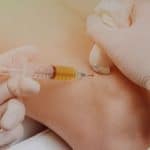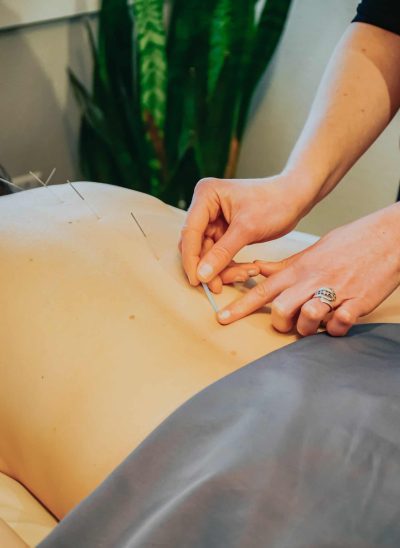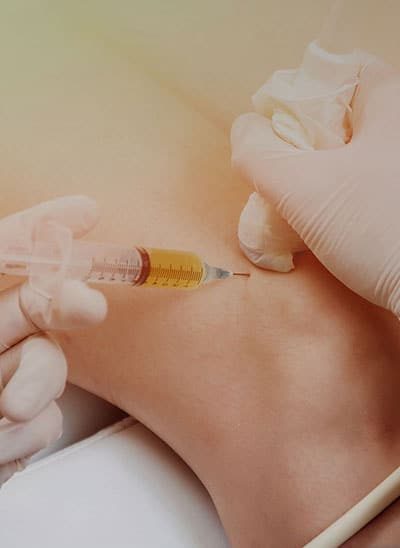The prolotherapy specialists at FoRM Health in Portland, Oregon have used this time-tested technique since they’ve been in practice. Prolotherapy (prolo = proliferative) has been around officially since the 1950s, with variants of the technique pre-dating that. The primary goal of this therapy is strengthening ligaments, which are the supportive structures of all joints. Prolotherapy can stimulate an immune response similar to PRP, and sometimes you may benefit from a combination of the two therapies together.
If you suffer from chronic joint pain where ligament damage is present, prolotherapy may effectively treat your joint through stabilizing these ligaments. Since the main component of the solution injected is typically dextrose (a type of sugar), this therapy is exceptionally safe, with minimal side effects or adverse reactions. Recent research also shows dextrose has a beneficial effect on nerve pain (see more about our nerve hydrodissection services here).
What conditions is Prolotherapy used for?
- Arthritis
- Chronic sprains, strains, tendonosis (Tennis elbow, plantar fasciitis, patellar tendonitis, achilles tendonitis, etc)
- Rotator cuff injuries
- Chronic shoulder subluxation (dislocation)
- Ligament laxity and joint instability, including Ehlers-Danlos spectrum
- Oshgood-Schlatters
- Chronic pain from motor vehicle accidents, whiplash
- Spine related pain (cervical, thoracic, lumbar, sacroiliac)
- Chronic headaches
- Rib, costovertebral pain
Schedule with FoRM Health’s Prolotherapy specialist in Portland, Oregon:
FAQ
Prolotherapy works by causing a mild inflammatory response at the site of injury, with an injected substance, typically dextrose. The inflammation results in a renewed healing response which helps to repair damaged tissues, such as ligaments and tendons.
Since the main component of the solution injected is typically dextrose (a type of sugar), the therapy was not funded for extensive trials, and lost favor to more extensively studied drug or surgical approaches over the years. In part due to its clinical success, however, along with its high level of safety as an injection therapy, more recent research has helped prove its effectiveness, including Level I studies (the top tier and most conclusive from a research standpoint). A landmark study proved undeniable benefit for knee arthritis, with several other smaller studies proving its use in other conditions, particularly those involving ligament damage or laxity. (For those wanting research, see Dr Dean Reeves’,of the University of Kansas School of Medicine, great summary here!)
In general, yes. Often prolotherapy is used for joint injuries which involves ligament damage or laxity (weakness). Since there are many ligaments around a joint, including the joint capsule itself, most if not all of the ligaments are treated to help get maximal stability. When a joint is injured (sprain, rolled ankle, etc) it is virtually impossible to injure just a single ligament because of the stretch that occurs through the entire joint.
A local anesthetic is used at the injection site to reduce needle/injection discomfort; this part is generally well tolerated. Prolo is meant to stimulate an immune response, which starts with inflammation (and is the reason for pain during any injury). Since prolo helps stimulate this response, there can be ranging degrees of increased soreness following treatment, on average for 2-3 days.
Tylenol is allowed for pain relief. Low dose opioid medications are occasionally prescribed for certain injections (typically only needed for 2-3 days following treatment). Anti-inflammatory (NSAIDs) and steroid medications are not allowed (rare exceptions) as these interfere with a normal inflammatory and healing response.
This depends on the type of injury, location, and length of time since onset. As a general rule, it takes 2-3 months for the initial stages of regeneration and repair to occur. At this point patients typically see and feel results. Repair processes can continue for many months after injections. For osteoarthritis, pain reduction can actually occur much more quickly, within a couple weeks. Also, dextrose can help with certain types of nerve irritation; injections may help reduce this type of pain much quicker.
Again, this varies depending on the condition. Prolo is usually better tolerated with quicker recovery than PRP, but time is still needed for healing. Typically major exercise is avoided for the first week after treatment, with return to normal activity levels over the 2nd week. Exceptions to this are discussed following the initial visit.
Baseline prolotherapy solutions include dextrose (a sugar), a small amount of anesthetic (usually lidocaine or procaine), and saline. Vitamin B12, testosterone, or other natural substances may be added depending on the condition or strength of response needed. Aside from the anesthetic, there are no other pharmaceutical medications used.
No. Prolotherapy with dextrose stimulates a regenerative response, with collagen production and strengthening/tightening of ligaments. This does not cause scarring. This should not be confused with sclerotherapy, another term often confused with prolo. Sclerotherapy involves injecting substances into damaged blood vessels, typically smaller veins, to irritate and destroy them.
Prolotherapy is generally very safe and well tolerated with most medications or other medical conditions. A full medical history is always reviewed prior to initiating treatment. Patients on immunosuppressive medications, active cancer, or infection around the site to be treated are contraindications to treatment.
While our office is located in SE Portland, Oregon, many of our patients travel from the greater Portland area, including: Lake Oswego, Beaverton, Hillsboro, Tigard, Milwaukie, Happy Valley, and Oregon City, for in-office visits and procedures. We also offer virtual office visits, which allows us to provide service to anyone seeking care within Oregon, with the exception of procedures which must be performed in office.
















